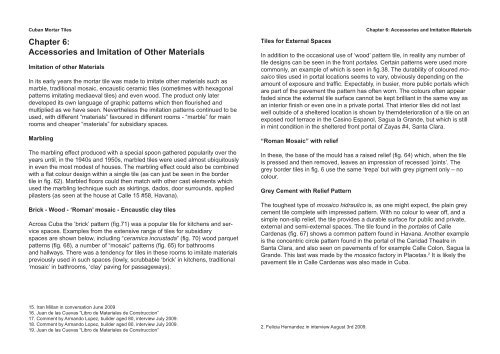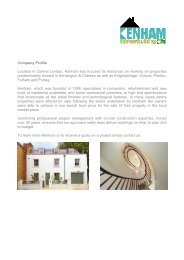Cuban Mortar Tiles - infogram.co.uk > Home
Cuban Mortar Tiles - infogram.co.uk > Home
Cuban Mortar Tiles - infogram.co.uk > Home
You also want an ePaper? Increase the reach of your titles
YUMPU automatically turns print PDFs into web optimized ePapers that Google loves.
<strong>Cuban</strong> <strong>Mortar</strong> <strong>Tiles</strong> Chapter 6: Accessories and Imitation Materials<br />
Chapter 6:<br />
Accessories and Imitation of Other Materials<br />
Imitation of other Materials<br />
In its early years the mortar tile was made to imitate other materials such as<br />
marble, traditional mosaic, encaustic ceramic tiles (sometimes with hexagonal<br />
patterns imitating mediaeval tiles) and even wood. The product only later<br />
developed its own language of graphic patterns which then fl ourished and<br />
multiplied as we have seen. Nevertheless the imitation patterns <strong>co</strong>ntinued to be<br />
used, with different “materials” favoured in different rooms - “marble” for main<br />
rooms and cheaper “materials” for subsidiary spaces.<br />
Marbling<br />
The marbling effect produced with a special spoon gathered popularity over the<br />
years until, in the 1940s and 1950s, marbled tiles were used almost ubiquitously<br />
in even the most modest of houses. The marbling effect <strong>co</strong>uld also be <strong>co</strong>mbined<br />
with a fl at <strong>co</strong>lour design within a single tile (as can just be seen in the border<br />
tile in fi g. 62). Marbled fl oors <strong>co</strong>uld then match with other cast elements which<br />
used the marbling technique such as skirtings, dados, door surrounds, applied<br />
pilasters (as seen at the house at Calle 15 #58, Havana).<br />
Brick - Wood - ‘Roman’ mosaic - Encaustic clay tiles<br />
Across Cuba the ‘brick’ pattern (fi g.71) was a popular tile for kitchens and service<br />
spaces. Examples from the extensive range of tiles for subsidiary<br />
spaces are shown below, including “ceramica incrustada” (fi g. 70) wood parquet<br />
patterns (fi g. 68), a number of “mosaic” patterns (fi g. 65) for bathrooms<br />
and hallways. There was a tendency for tiles in these rooms to imitate materials<br />
previously used in such spaces (lowly, scrubbable ‘brick’ in kitchens, traditional<br />
‘mosaic’ in bathrooms, ‘clay’ paving for passageways).<br />
15. Iran Millan in <strong>co</strong>nversation June 2009<br />
16. Juan de las Cuevas “Libro de Materiales de Construccion”<br />
17. Comment by Armando Lopez, builder aged 80, interview July 2009.<br />
18. Comment by Armando Lopez, builder aged 80, interview July 2009.<br />
19. Juan de las Cuevas “Libro de Materiales de Construccion”<br />
<strong>Tiles</strong> for External Spaces<br />
In addition to the occasional use of ‘wood’ pattern tile, in reality any number of<br />
tile designs can be seen in the front portales. Certain patterns were used more<br />
<strong>co</strong>mmonly, an example of which is seen in fi g.38. The durability of <strong>co</strong>loured mosai<strong>co</strong><br />
tiles used in portal locations seems to vary, obviously depending on the<br />
amount of exposure and traffi c. Expectably, in busier, more public portals which<br />
are part of the pavement the pattern has often worn. The <strong>co</strong>lours often appear<br />
faded since the external tile surface cannot be kept brilliant in the same way as<br />
an interior fi nish or even one in a private portal. That interior tiles did not last<br />
well outside of a sheltered location is shown by themdeterioration of a tile on an<br />
exposed roof terrace in the Casino Espanol, Sagua la Grande, but which is still<br />
in mint <strong>co</strong>ndition in the sheltered front portal of Zayas #4, Santa Clara.<br />
“Roman Mosaic” with relief<br />
In these, the base of the mould has a raised relief (fi g. 64) which, when the tile<br />
is pressed and then removed, leaves an impression of recessed ‘joints’. The<br />
grey border tiles in fi g. 6 use the same ‘trepa’ but with grey pigment only – no<br />
<strong>co</strong>lour.<br />
Grey Cement with Relief Pattern<br />
The toughest type of mosai<strong>co</strong> hidrauli<strong>co</strong> is, as one might expect, the plain grey<br />
cement tile <strong>co</strong>mplete with impressed pattern. With no <strong>co</strong>lour to wear off, and a<br />
simple non-slip relief, the tile provides a durable surface for public and private,<br />
external and semi-external spaces. The tile found in the portales of Calle<br />
Cardenas (fi g. 67) shows a <strong>co</strong>mmon pattern found in Havana. Another example<br />
is the <strong>co</strong>ncentric circle pattern found in the portal of the Caridad Theatre in<br />
Santa Clara, and also seen on pavements of for example Calle Colon, Sagua la<br />
Grande. This last was made by the mosai<strong>co</strong> factory in Placetas. 2 It is likely the<br />
pavement tile in Calle Cardenas was also made in Cuba.<br />
2. Felicia Hernandez in interview August 3rd 2009.



